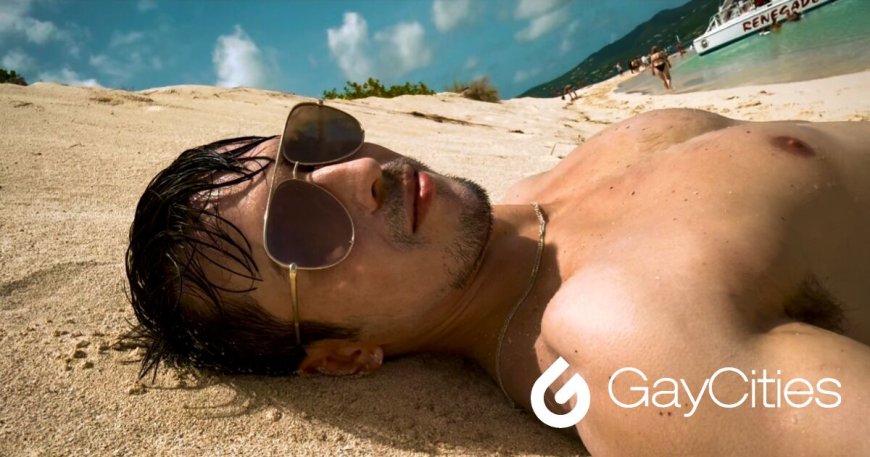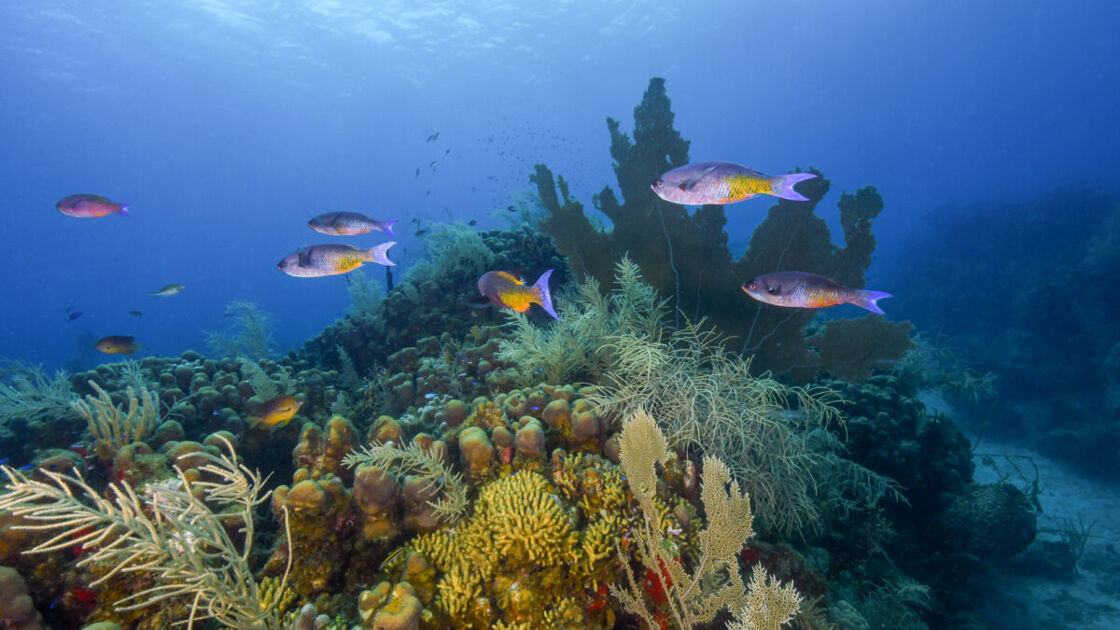Finding power in (small) numbers at St. Croix Pride
Queer people swim in all directions, a combustion of color and layered history - except for once a year when we fall in line worldwide.


While snorkeling on Buck Island in St. Croix, I followed a school of blue fish, propelling my body toward their sphere, but I couldn’t infiltrate it.
Having never snorkeled before, I faced the wrath of the red-faced, blonde female captain of Caribbean Sea Adventures, who scolded me for not disclosing my inexperience before it was time to don the gear and plunge into the turquoise sea. I bit my sassy tongue, determined not to spoil my first encounter with a woman at the helm of a boat.

Pack your bags, we’re going on an adventure
Subscribe to our weekly newsletter for the best LGBTQ+ travel guides, stories, and more.
Subscribe to our Newsletter today
I was pleased to learn snorkeling was easy: breathe through your mouth and avoid hurting yourself against the boulders of rock and algae. My silver necklace and rings dazzled in the water. I couldn’t help but admire the shine of my swim strokes, the scales of my fabulosity.
Naturally, my black speedos, adorned with a golden bull ring at the waistband, were out of sync with the strictly royal blue gang. I wanted to see if I could get them to split up, to test the will of their togetherness. The fish managed to dodge me without even acknowledging my presence.
At St. Croix Pride, I thought about the homogeneity of marine life as I watched the town’s LGBTQ+ community and allies march down the streets of Frederiksted. The queer identity is nothing like a school of fish. After all, there is no species more egotistical and individualistic than humanity, yet folks manage to condemn each other with such narrow mentalities.
Queer people swim in all directions, a combustion of color and layered history. That is, except for once a year when we fall in line worldwide to march for equal rights, blending our innate differences with the inclusive symbolism of the rainbow.

Leading the parade was Jenn Koockogey-Lajoie, a lawyer and the St. Croix Pride board vice president. She proudly waved the bisexual flag, strutting forward the designated barricaded streets in a rainbow tutu. Her dubbed “husbear” cheered her on from the sidelines. Behind Koockogey-Lajoie were different car floats and marchers, most strikingly, a couple of hot gay men in warrior gear with all the right moves and the colorful Cruzan Cowgirls riding their stallions like Amazonians.
Koockogey-Lajoie later joked about placing the Cruzan Cowgirls at the end of the march after one year, where they rode in the middle. Their horses’ presence was felt and smelled by fellow marchers and attendees long after they were seen.

I’ll admit St. Croix Pride felt underwhelming: there were no more than 50 marchers, and I kept wondering where all the gays were. Was there a coinciding circuit party I wasn’t aware of? Hailing from New York, I was used to a march typically stretching miles of people.
“We’re a small island, and we have a small Pride. We’re grateful for the support we get,” Koockogey-Lajoie told me. “It’s a lot of effort and paperwork just to have this celebration, but it’s worth it.”

In 2018, St. Croix made Pride part of its yearly tradition following the aftermath of Hurricane Maria, which had devastated the town and left families without power for months. The first celebration was held on a community member’s porch. As seen repeatedly in marginalized history, the challenges might be nuanced to identity and geography, but humanity knows how to find light in dark times. Change does not wait for convenience.
Through this lens, St. Croix queer locals raved that this year was their biggest Pride yet. At the subsequent block party, Koockogey-Lajoie shared that anti-gay protesters accosted one of the marchers. A person made a wrong turn and drove their float past the police barricades by a fish market where some men gathered to object to Pride being held in their town.

I never saw an anti-gay protest in real life, so I convinced Queerty contributor Carson Mlnarik to accompany me to walk by them discreetly. The investigative journalist in me wanted to stare at the eyes of hate, perhaps with the same curiosity that made me stalk the school of fish. Someone who could oppose my existence didn’t feel like the same species as me.
I recognized the fish market because it was next to a pier where I had taken a selfie that morning during my stroll to Polly’s at the Pier, one of the best breakfast spots on this side of town. I felt nervous approaching them, remembering the adage, “Curiosity killed the cat.” However, I saw a group of Rastafarian guys slumped on chairs, listening to soulful music I’d groove to. “You can keep your Pride,” a chorus sang melancholically, the lyrics presumably implying I should take my gayness elsewhere.
I braced for them to hurl slurs, but they continued about their business. They didn’t look angry, maybe because the march had ended and there was no loud queerness in front of them. We returned to meet our group for a seafood lunch at Eat With Fred, where the Cruzan Cowgirls coincidentally enjoyed drinks at the bar.

My friends wanted to check out Point Udall, the easternmost point of the United States, while I preferred to avoid an hour in a van and enjoy one of the purest pleasures in life: smoking a blunt on a pristine beach with the sun and breeze kissing my skin. Thankfully, marijuana was decriminalized on the island; I just had to find it. I tapped one of the Cruzean Cowgirls on the shoulder for help.
“There’s a park where people sell it,” she said. “I buy from them all the time, just never start with ‘hello,’ say ‘good afternoon, how are you doing… can I buy…’”
Unfortunately, their instructions led me face to face once again with the men at the fish market, the anti-gay protesters.

I quickly removed all my jewelry and a Pride pin I was wearing on my shorts, wondering if I was really going to approach enemy territory. I often criticized corporations that donated to anti-gay politicians, and here I was, sacrificing my morals for a toke and abusing my privilege to hide.
But I secretly wanted to speak with them. After all, a group of Black men should know what it’s like to be judged just for their appearances, to be in danger of harm or prejudice just because they’re gathering as a group. Our identities shared more woes than differences if sex was taken out of the equation. (Then again, penetration works the same regardless of the hole.)
“Good afternoon,” I said. “How are you doing?”
“Yeah?” one of them responded in a friendly tone.
I chickened out and pretended to just want to compliment their music. I put my jewelry and pin back on and headed back to Sand Castle on the Beach, where I was staying. A gay couple owns it and has made it the most welcoming space for LGBTQ+ people on the island, including a big Pride pool drag bash the weekend after the march. As I continued home, I noticed a park adjacent to the fish market with a woman sitting on a bench, licking a blunt closed.
“Good afternoon… uh, excuse me,” I said as the lady took a hit of the blunt, “Do you know where I can buy one of those?”

She pointed to another woman behind me, who could’ve been the mother of one of the guys at the fish market. She waved me over. She said they sell them in vials for $10, and I asked for two. I handed her the money, and she proceeded to retrieve the weed from the anti-gay protesters. She pounded my fist and smiled goodbye. Their community seemed to be as small as the gays on the island, and yet they were individuals.
I realized I didn’t have anything to smoke out of. A man sat finishing a joint at the end of the park, embodying the same Rastafarian style as the guys at the fish market. But I knew better than to generalize and offered him $20 to roll me two joints.
“I’ll teach you how to do it,” he said, “so you don’t have to waste $20 so stupidly again.”
His name was Lion, and he had a matching tattoo on his pecs. I sat there and pretended to keep up with his instructions and the machine-like speed as he rolled each joint, if only to avoid ruining the joy of the interaction.

I met with the Pride board’s president, Imani Evans, for brunch at Sand Castle the following day. She reckoned there were probably about 100 openly queer people on the island, which made the community palpably aware of each other. “When we get queer tourism, it spices up the situation,” she added, waving her hands with a cheeky smile.
“The gay population triples if you also include people living with longtime ‘roommates’ or secretly hooking up with mutual friends,” she said, and statistically more when you consider queer people make up at least 7% of the US population. That’s the ripple effect of visibility in places creating their own queer history. An anti-gay protest surely means that queerness is finding its voice on the island.
St. Croix is predominantly Christian, and Evans reflected on how people threatened her parents that they would kill or rape her if they let her leave the house when she joined the Pride organization at its inception at 17. She acknowledges that despite being Black, Puerto Rican, and a lesbian, her light skin and successful parents gave her privilege.
“My father threatened to disown me but then showed up at my first Pride march with a Glock to ensure I was safe,” she added. Now Evans is the youngest president of the Pride board, a leadership task she says is anything but rainbows and kumbaya. The LGBTQ+ community has strong opinions and different approaches to grassroots organizing and visibility.
“The reality is I’ve never seen any Pride board—anywhere—where everyone perfectly gets along,” she said.
Queer people work together for the greater good, our survival. Just as the ladies at the park and the men at the fish market. But the magical aspect about queerness is that it can permeate any social group in any geography, and all it takes for one person to come forward to potentially cure the homophobia of those who love them (or put them on a path for chosen family with the community).
With a population of about 50,000+ people, even the smallest glimmers of visibility in St. Croix can quickly connect the human dots and empower people to care about equality. Humans might never all swim in the same direction—or be surrounded by a community in droves—but what matters is that everyone in all regions believes in the power of their own stroke.

 Mark
Mark 





